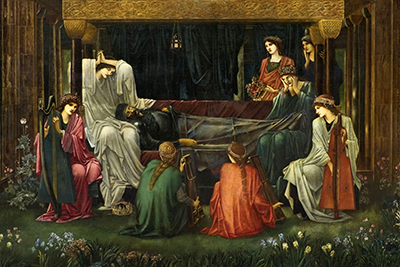The Last Sleep of Arthur in Avalon is surely the widest painting completed by Edward Burne-Jones, stretching to an impressive six and a half metres across.
This artist was famous for his love of the Arts and Crafts, finding painting sometimes restrictive in that items in that medium would often have to be smaller. He did not wish to design art for exhibiting, but rather for the installation in other places. His work with huge stained glass windows is another example of this. In the case of The Last Sleep of Arthur in Avalon, he chose to abandon these concerns completely and formulate a painted composition on a huge scale. Such was the colossal size of this piece that many online appraisals of it feel obliged to handle different areas of detail separately, rather than trying to display the entire artwork in one photograph.
This painting would become incredibly personal and important to the artist, who continued to work on it right up to his death. It remained uncompleted, but is still amongst his most famous paintings in spite of that. Burne-Jones would several close companions prior to his own death and it is possible that some of them are captured as characters within this scene. His own wife's memoirs would again confirm the importance of this painting to her late husband. The painting would in the modern day be subject to controls to prevent it being sold outside of the UK but at the time of its sale to its current owner the artist was not considered important enough to warrant kicking up a fuss.
Elements of the overall composition gives clues as to the other mediums in which this artist was involved. See the architectural flourishes in the background of the central area, for example. This matches directly to Burne-Jones' work in theatrical stage design. In the near foreground we then find pretty patterns of flowers which point to his many tapestry designs. When viewing this piece up close it is easy to understand quite how it took so long to even just get it to this point.




